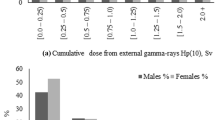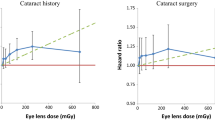Abstract
This study is the first to report cataract type specific risks in a cohort of Russian Mayak Production Association workers following chronic occupational exposure to ionizing radiation. In this retrospective cohort study, 22,377 workers (females 25.4%) first employed in 1948–1982 were followed up till the end of 2008. All cataract subtypes were significantly dependent on sex, attained age, diabetes mellitus, myopia and glaucoma. For each of posterior subcapsular (PSC), cortical and nuclear cataracts, the risk of cataract incidence significantly linearly increased with increasing radiation dose. Excess relative risk per unit effective dose (ERR/Sv) from external γ-rays based on the linear model was 0.91 [95% confidence intervals (CIs) 0.67, 1.20] for PSC, 0.63 (95% CIs 0.49, 0.76) for cortical, and 0.47 (95% CIs 0.35, 0.60) for nuclear cataracts. For all three types of cataracts, exclusion of an adjustment for neutron dose as well as inclusion of additional adjustments for body mass index and smoking index decreased ERR/Sv of external γ-rays. Inclusion of an additional adjustment for glaucoma, however, modestly increased incidence risks for cortical and nuclear cataracts, but not PSC cataracts. Inclusion of an adjustment for diabetes mellitus decreased ERR/Sv of external γ-rays only for PSC incidence. Both males and females had increased risks for all three types of cataracts, but ERR/Sv was significantly higher in females than in males (p < 0.001), particularly for PSC cataracts. The results suggest that chronic occupational radiation exposure significantly increases risks of PSC, cortical and nuclear cataracts, and that such risks are higher in females than in males.


Similar content being viewed by others
References
Ainsbury EA, Barnard S, Bright S, Dalke C, Jarrin M, Kunze S, et al. Ionizing radiation induced cataracts: recent biological and mechanistic developments and perspectives for future research. Mutat Res. 2016;770(Pt B):238–61 (PMID: 27919334).
ICRP. ICRP Statement on tissue reactions/early and late effects of radiation in normal tissues and organs—threshold doses for tissue reactions in a radiation protection context. ICRP Publication 118. Ann. ICRP 41(1/2), 2012.
Hamada N, Fujimichi Y. Classification of radiation effects for dose limitation purposes: history, current situation and future prospects. J Radiat Res. 2014;55(4):629–40 (PMID: 24794798).
Shore RE. Radiation and cataract risk: impact of recent epidemiologic studies on ICRP judgments. Mutat Res. 2016;770(Pt B):231–7 (PMID: 27919333).
Rafnsson V, Olafsdottir E, Hrafnkelsson J, Sasaki H, Amarsson A, Jonasson F. Cosmic radiation increases the risk of nuclear cataract in 3984 airline pilots: a population-based case-control study. Arch Ophthalmol. 2005;123(8):1102–3985.
Hamada N, Sato T. Cataractogenesis following high-LET radiation exposure. Mutat Res. 2016;770(Pt B):262–91 (PMID: 27919335).
NCRP (2016) Guidance on radiation dose limits for the lens of the eye. NCRP Commentary No. 26. National Council on Radiation Protection and Measurements, Bethesda, MD
Azizova TV, Bragin EV, Hamada N, Bannikova MV. Risk of cataract incidence in a cohort of Mayak PA workers following chronic occupational radiation exposure. PLoS ONE. 2016;11(10):e0164357.
ICD-9 guidelines for coding diseases, injuries and causes of death/revision 1975. Geneva, Switzerland: WHO; 1980
Azizova TV, Day RD, Wald N, Muirhead CR, O’Hagan JR, Sumina MV, et al. The “Clinic” medical-dosimetric database of Mayak production association workers: structure, characteristics and prospects of utilization. Health Phys. 2008;94:449–58.
Vasilenko EK, Scherpelz RI, Gorelov MV, Stram DJ, Smetanin MY. External dosimetry reconstruction for Mayak workers. 2010. AAHP Special session health physics society annual meeting. http://www.hpsl.org/aahp/public/AAHP_Special_Session/2010_Salt_Lake_City/pm-1.pdf.
Khokhryakov VV, Khokhryakov VF, Suslova KG, Vostrotin VV, Vvedensky VE, Sokolova AB, et al. Mayak Worker Dosimetry System 2008 (MWDS-2008): assessment of internal alpha-dose from measurement results of plutonium activity in urine. Health Phys. 2013;104:366–78.
ICRP. 2007 Recommendations of the International Commission on Radiological Protection. ICRP Publication 103. Ann. ICRP 37 (2-4), 2007.
Preston D, Lubin J, Pierce D, McConney M. Epicure users guide. Seattle: Hirosoft; 1993.
Klein BE, Klein R, Linton KL. Prevalence of age-related lens opacities in 3669 a population. The Beaver Dam eye study. Ophthalmol. 1992;99(4):546–52.
Vavvas D, Azar NF, Azar DT. Mechanisms of disease: cataracts. Ophthalmol Clin North Am. 2002;15(1):49–60.
Minamoto A, Taniguchi H, Yoshitani N, Mukai S, Yokoyama T, Kumagami T, et al. Cataract in atomic bomb survivors. Int J Radiat Biol. 2004;80(5):339–45 (PMID: 15223766).
Neriishi K, Nakashima E, Minamoto A, Fujiwara S, Akahoshi M, Mishima HK, et al. Postoperative cataract cases among atomic bomb survivors, radiation dose response and threshold. Radiat Res. 2007;168:404–8.
Henderson MA, Valluri S, DesRosiers C, Lopez JT, Batuello CN, Caperell-Grant A, et al. Effect of gender on radiation-induced cataractogenesis. Radiat Res. 2009;172(1):129–33 (PMID: 19580515).
Henderson MA, Valluri S, Garrett J, Lopez JT, Caperell-Grant A, Mendonca MS, et al. Effects of estrogen and gender on cataractogenesis induced by high-LET radiation. Radiat Res. 2010;173(2):191–6 (PMID: 20095851).
Dynlacht JR. The role of age, sex and steroid sex hormones in radiation cataractogenesis. Radiat Res. 2013;180(6):559–66 (PMID: 24261552).
Hamada N. Ionizing radiation sensitivity of the ocular lens and its dose rate dependence. Int J Radiat Biol. 2017;93(10):1024–34 (PMID: 27899034).
ICRP. ICRP Statement on tissue reactions/early and late effects of radiation in normal tissues and organs—threshold doses for tissue reactions in a radiation protection context. ICRP Publication 118. Ann. ICRP 41(1/2), 2012.
Dynlacht JR, Vallury S, Garrett J, Mendonca MS, Lopez JT, Caperell-Grant A, et al. Age and hormonal status as determinants of cataractogenesis induced by ionizing radiation. I. Densely ionizing (high-LET) radiation. Radiat Res. 2011;175(1):37–43.
Bigsby RM, Valluri S, Lopez J, Mendonca MS, Caperell-Grant A, DesRosiers C, et al. Ovarian hormone modulation of radiation-induced cataractogenesis: dose-response studies. Invest Ophthalmol Vis Sci. 2009;50(7):3304–10. https://doi.org/10.1167/iovs.08-3262.
Dynlacht JR, Tyree C, Valluri S, DesRosiers C, Caperell-Grant A, Mendonca MS, et al. Effect of estrogen on radiation-induced cataractogenesis. Radiat Res. 2006;165:9–15.
Dynlacht JR, Valluri S, Lopez J, Greer F, DesRosiers C, Caperell-Grant A, Mendonca MS, et al. Estrogen protects against radiation-induced cataractogenesis. Radiat Res. 2008;170:758–64.
Theodoropoulou S, Theodossiadis P, Samoli E, Vergados I, Lagiou P, Tzonou A. The epidemiology of cataract: a study in Greece. Acta Ophthalmol. 2011;89:167–73. https://doi.org/10.1111/j.1755-3768.2009.01831.x (PMID: 20064113).
Kanthan GL, Wang JJ, Burlutsky G, Rochtchina E, Cumming RG, Mitchell P. Exogenous oestrogen exposure, female reproductive factors and the long-term incidence of cataract: the Blue Mountains Eye Study. Acta Ophthalmol. 2010;88:773–8. https://doi.org/10.1111/j.1755-3768.2009.01565.x (PMID: 19489760).
Wu R, Wang JJ, Mitchell P, Lamoureux EL, Zheng Y, Rochtchina E, et al. Smoking, socioeconomic factors, and agerelated cataract: the Singapore Malay Eye study. Arch Ophthalmol. 2010;128:1029–35. https://doi.org/10.1001/archophthalmol.2010.147 (PMID: 20697004).
Tan JS, Wang JJ, Younan C, Cumming RG, Rochtchina E, Mitchell P. Smoking and the longterm incidence of cataract: the Blue Mountains Eye Study. Ophthalmic Epidemiol. 2008;15:155–61. https://doi.org/10.1080/09286580701840362 (PMID: 18569810).
Lindblad BE, Hakansson N, Philipson B, Wolk A. Alcohol consumption and risk of cataract extraction. Ophthalmology. 2007;114:680–5. https://doi.org/10.1016/j.ophtha.2006.07.046 (PMID: 17173974).
Morris MS, Jacques PF, Hankinson SE, Chylack LT Jr, Willett WC, Taylor A. Moderate alcoholic beverage intake and early nuclear and cortical lens opacities. Ophthalmic Epidemiol. 2004;11:53–65. https://doi.org/10.1076/opep.11.1.53.26439 (PMID: 14977497).
Rahman A, Yahya K, Shaikh A, Fasih U, Zuberi BF. Risk factors associated with pre-senile cataract. Pak J Med Sci. 2011;27:145–8.
Otake M, Schull WJ. A review of forty-five years study of Hiroshima and Nagasaki atomic bomb survivors. Radiation cataract. J Radiat Res. 1991;32:283–93.
Nakashima E, Neriishi K, Minamoto A. A reanalysis of atomic-bomb cataract data, 2000–2002, a threshold analysis. Health Phys. 2006;90:154–60.
Chylack LT Jr, Peterson LE, Feiveson AH, Wear ML, Manuel FK, Tung WH, et al. NASA study 3288 of cataracts in astronauts (NASCA). Report 1: cross-sectional study of the relationship of exposure to space radiation and risk of lens opacity. Radiat Res. 2009;172(1):10–20.
Hall P, Granath F, Lundell M, Olsson K, Holm LE. Lenticular opacities in individuals exposed to ionizing radiation in infancy. Radiat Res. 1999;152:190–5.
Worgul BV, Kundiyev YI, Sergiyenko NM, Chumak VV, Vitte PM, Medvedovsky C, et al. Cataracts among Chernobyl clean-up workers, implications regarding permissible eye exposures. Radiat Res. 2007;167:233–43.
Author’s Contributions
TVA conceived and designed the study, and produced an analytical plan. ESG was responsible for statistical analysis of data. TVA, NH, EVB and ESG interpreted the results and produced the initial draft. All authors provided intellectual input and approved the manuscript. TVA is the guarantor.
Funding
The authors received no specific funding for this work.
Author information
Authors and Affiliations
Corresponding author
Ethics declarations
Conflict of interest
The authors declare no competing interests.
Electronic supplementary material
Below is the link to the electronic supplementary material.
Rights and permissions
About this article
Cite this article
Azizova, T.V., Hamada, N., Grigoryeva, E.S. et al. Risk of various types of cataracts in a cohort of Mayak workers following chronic occupational exposure to ionizing radiation. Eur J Epidemiol 33, 1193–1204 (2018). https://doi.org/10.1007/s10654-018-0450-4
Received:
Accepted:
Published:
Issue Date:
DOI: https://doi.org/10.1007/s10654-018-0450-4




